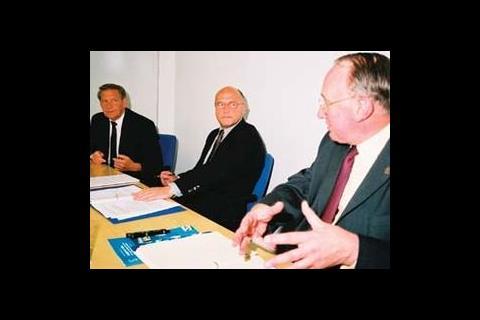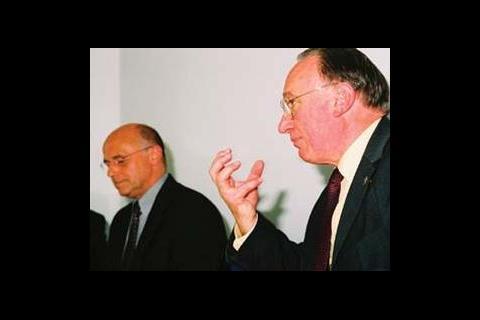George Bernard Shaw said America and Britain (well, he mentioned England, but we won't split hairs) are two nations divided by a single language. They are also separated by very different attitudes to construction, and services engineering. In this presidential debate, Richard Rooley of ASHRAE and CIBSE's Terry Wyatt, were on opposite sides of the partnering fence. Wyatt believes that partnering and teamworking are necessary to produce better and more sustainable buildings. Rooley feels that we should all move on from talking about partnering, and deal instead with the issue that engineering lacks leadership; that engineers need to step forward more and present their case to clients better.
ASHRAE president, Richard Rooley, is British – the first non-North American to hold the post. He's in a good position therefore to highlight the differences in the way the two countries approach the building process. This, he says, is at the root of conflicting attitudes to working methods. "In the USA, we have an architect-led culture. The architect calls in a services consultant and the engineer gets about two thirds of the fee that the architect gets for that part of the job. For the majority of buildings, I would say 60%, the architect sets costs and sets the programme."
Rooley says that in the USA, standards are prescriptive. "We have to give the engineer a check-box design. It's not interpretive and performance-related as in the UK. We work very well that way."
But for Rooley, the key problem that American engineers face is an inability to have their voice heard by the architect. "The majority of architects are very blinkered. And engineers don't have the presentation skills, or the ability to argue their case."
In the American construction industry, it's clear that the services engineer is very much at the lower end of the pecking order and it is easy to see where Rooley's call for greater assertiveness comes from. But is it really the case that we need to exchange one strong leader (the architect) for another? If we resort to standing up for ourselves, aren't we really heading towards the adversarial working we're trying to get away from in the UK?
Terry Wyatt on the other hand, believes that teamwork is key to producing buildings which work for the client, and for the environment. He draws on his early experiences in construction: "The buildings I first worked on were designed by the architect. And there was never enough budget for services – the thinking was that services weren't really needed. As services engineers, we were fighting for space from the architect, and the structural engineer. We were at the bottom of the pile with no authority and all the responsibility. We rarely got to meet the client, unless someone had to take the blame!"
CIBSE's president believes that things have now changed for the better, with clients realising the valuable contribution services make to buildings. Teamwork has been key to this change: "We have to work as a team, and triumph as individuals. All crucial design decisions have to be devised before the first meeting. Decisions at high level cost nothing but have a big effect on the job." Even though the US method creates cheap buildings, they are, says Wyatt 'awful'.
"The focus should be related to the performance of the product, rather than the cost of the product. But this can only be done when working in partnership with clients who share the respect, responsibility and rewards," adds Wyatt.
The other factor driving teamworking is the increasing use of standardisation, and prefabrication. This is difficult to carry through in an industry where clients want a unique product. "Architects don't want to know about standard systems because they interfere with their creativity, and consulting engineers are the same. Manufacturers therefore find it difficult to sell a standard product," says Wyatt.
But Rooley believes there is too much talk about teamworking. "We need leadership. Teamwork and the process are nothing – let's just get on and do it! The process is too easy to debate. Leadership of the whole team and management skills of the m&e engineer are what we need to concentrate on," says the ASHRAE leader.
Fundamentally, Rooley doesn't see teamwork as an issue, because he thinks we're already doing it. Many would disagree with this, saying that the UK construction industry has a long way to go to achieve anything like the level of integrated working that Egan had in mind in his Accelerating change report.
Both presidents do agree however, that engineers need to be better at making their case to clients and the rest of the construction team. "Partnering and teamworking do not necessarily produce a better product for the clients. When you quote Egan, he's talking about process and technology, not leadership. What I am saying is that we will have in place the process, but not the leadership. We lack the ability to present our case. The engineer is woefully poor at standing up for himself on both sides of the Atlantic," says Rooley.
Finally, however, Wyatt makes a stand for teamworking on sustainability grounds. An integrated approach he says, is absolutely necessary to produce buildings which are more sustainable, and waste less energy in their lifetimes.
He describes buildings as 'weapons of mass destruction, pouring out their poison day-after-day' and there's no doubt that as far as he's concerned only a concerted, team-based effort will prevent more of this kind of building being created.
At the end of the day, there's not so much conflict between the two presidents' views; more a difference of emphasis. It does become clear though, that the USA has a long way to go before its engineers start to gain the respect from clients and architects which is already being won by their CIBSE counterparts.
The US construction industry is also very hampered by the general litigious frame of mind. There's little engineer-driven innovation simply, says Rooley, because their insurance companies won't allow it.
Teamwork, with the emphasis on discussion, openness and exchange of ideas, probably wouldn't work that well in the USA anyway. Given the choice of which side of the Atlantic to work on, we're unlikely to see UK engineers moving over just yet.
Source
Building Sustainable Design


























No comments yet